Best Time To Visit the South Of France & Why (+Weather)
Are you booking a trip to Provence and the Riviera and wondering when the best time to visit the South of France is? I had the same question when I was planning my trips this past year, and the answer really depends on what you’re looking to experience – village life, city life, wine life, local festivals, lavender fields, and the list goes on.
I have been both in the summertime and in September and October, and each of my trips has been phenomenal, both weather-wise and natural beauty/activity-wise.
In this guide, I’ve included what is best to see in the South of France month to month and the associated weather by season. At the end of the day, any time between May and October is the best time to visit the south of France, but here is the quick and dirty of the months I think are great and why:
👉 May – October: Best for French Riviera beaches – St. Tropez, Cannes, Nice
👉 June: Best for red poppy (coquelicots) season
👉 July: Best for Lavender Fields in Provence (BEST OVERALL)
👉 August: Best for Sunflower Blooms in Provence
👉 September: Best for local festivals & vineyard visits (MY FAVORITE)
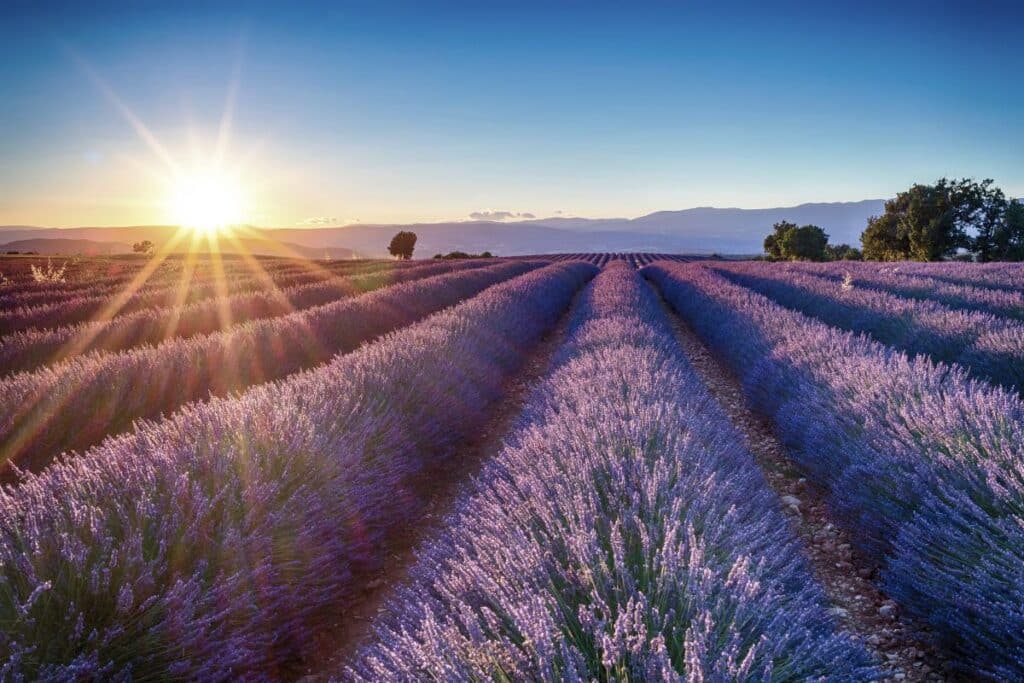
Before I get into the details, I would also suggest NOT visiting the south of France at certain times, like the winter months of November through April, when the cold Mistral wind blows through and freezes everyone around.
Overall Best Time to Visit the South of France
I think the best overall time to visit the south of France is between May and October. I especially like the months of July and September because they have the best weather and the longest days, and it’s either lavender or wine season, which I feel is iconic for the region.
Temperatures are around 80-90°F, which is about 26-32°C in July, and just a bit cooler in September.
Summertime (especially July) is full of festivals from village to village, and it is prime time for all the flowers to bloom – red poppies in June, lavender season in July, and sunflowers in August.
The fall season (especially September) is all about collecting the grape harvest and chunking up on great local foods, and of course, wine tasting at the many vineyards in Provence.
Best Time to Visit the South of France by Month
I would use this as your guide for when to visit. I’ve included the weather, why to go or avoid each month, and a few things to do in the South of France when visiting.

Weather in January – Bitter Cold
Honestly, just don’t go in January or any of the winter months, December through April.
January is the beginning of the year, and temperatures are in the 40s Fahrenheit, but the Mistral wind, a strong, cold wind that blows from northwest France into southern France and down into the Mediterranean, adds a chill to the air that will freeze your tushy.
Weather in February – Cold & Windy
Same as January, but bleaker. Temperatures generally range from about 37°F to 55°F. The wind is still blowing, and while there are a few cold sunny days, February in the South of France is mostly windy, cold, and rainy.
The only thing that’s happening in February is the Nice Carnival, one of the largest and most famous carnivals in France. It usually takes place in February, and the vibe is all about parades, flower battles, and lots of festival-type activities.
Weather in March – Cold & Windy
March in the South of France signifies the beginning of spring, with the weather gradually warming up, although it is still quite cold. Temperatures typically range from about 45°F to 60°F, and that Mistral wind is still blowing.
If you find yourself in the south, you’ll notice the region waking up from its winter sleep as flowers start to bloom and outdoor cafes begin to fill up again.
The milder weather is perfect for visiting the botanical gardens and parks that begin to show their spring colors – some of my favorites are Villa Ephrussi de Rothschild in Saint-Jean-Cap-Ferrat or the Jardin Exotique in Eze.
March will have a few local festivals and events celebrating the start of spring. My best recommendation if you are around is the Fête du Citron (Lemon Festival) in Menton, which usually takes place in late February and sometimes extends into March – it is WILD!
Weather in April – Cold & Rainy
April in the South of France has a bit more consistent spring weather, with temperatures becoming milder, usually ranging from about 50°F to 65°F. I still think it is a clusterfuck on what you’re going to get – thunderstorms or sunshine?
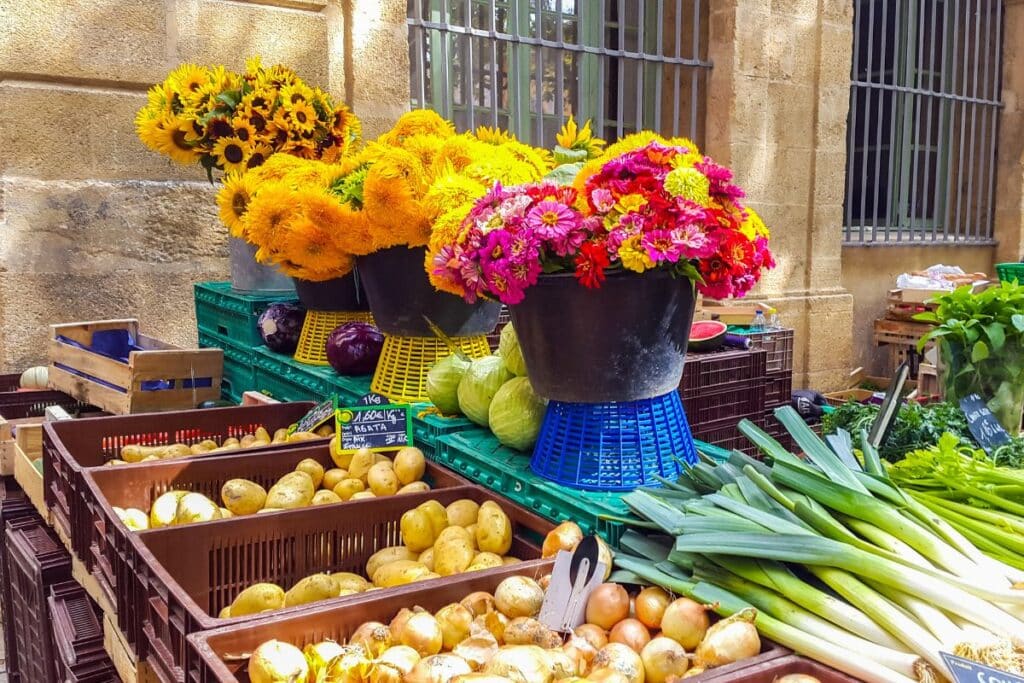
The days are longer and sunnier, but there’s still a chance of rain, so it’s smart to pack layers and a waterproof jacket.
As far as what there is to do in April, it’s the month of Easter, so quite a few events tailored to Jesus take place. Here are the top 3 things happening in April in the south of France:
- Feria de Pâques (Easter Feria) in Arles: This festival marks the beginning of the French bullfighting season and is a significant event in the city of Arles. It combines traditional bullfights with concerts, street performances, and parades. I went to a similar festival in Arles in September!
- Nice International Film Festival: Held in Nice, this festival is not as famous as the Cannes Film Festival, but it is still great!
- Festival des Jardins (Garden Festival) in Côte d’Azur: Although it typically starts in April and runs into May, this festival celebrates the beauty of gardens with events and garden displays across the Riviera.
Weather in May – Pleasant
Now, we are getting into summer territory! May in the South of France is pretty and pleasant, with sunshine and warmth to go around. Temperatures typically range from about 55°F to 72°F, although they can be higher, especially towards the end of the month.
I think May is perfect for exploring the Provençal countryside or the French Riviera (although the water is still a bit cold). The fields are alive with colors, and the weather is ideal for hiking, cycling, or picnicking in places like the Luberon and Gorge du Verdon.
A super popular event in May is the Cannes Film Festival, one of the most prestigious and publicized film festivals in the world. While access to the screenings is by invitation only, the atmosphere in Cannes is electric, and there are many smaller related events and opportunities for celebrity spotting.
Weather in June – Sunny & Dry
June in the South of France marks the transition from spring to summer, and temperatures typically range in the 60s to 70s Fahrenheit. I think you should aim to go more in the later part of the month to feel the warmth of the sun on your face but to be fair, June is a great time to visit as the weather is comfy, and the full summer crowds haven’t yet arrived.
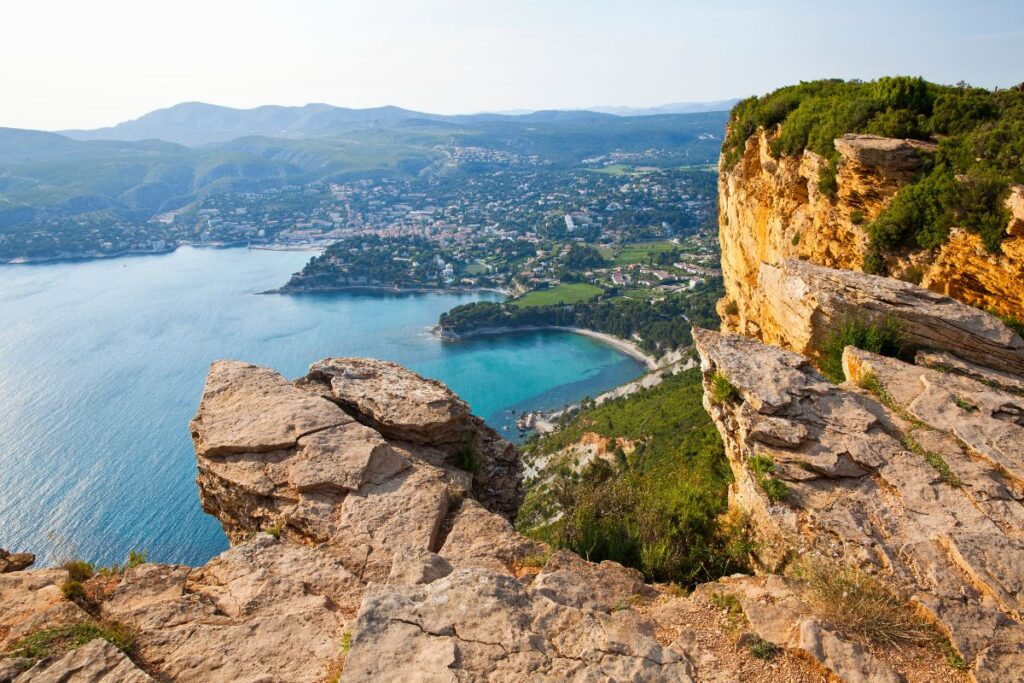
FUN THING TO DO: The Fête de la Musique on June 21st is a nationwide celebration of music with free concerts and performances in cities and towns across France – you can’t miss it! I caught one in Strasbourg (north France), and it was an all-out street festival everywhere – amazing!
Tourism starts to pick up in June, but it’s not as busy as in July or August, making it a good time to explore Provence and the Riviera without the peak season crowds. You’ll find a more chill atmosphere, easier travel logistics, and generally better deals on lodging and activities compared to the high summer months.
Plus, the mild weather is perfect for hiking, cycling, or kayaking, especially in areas like the Verdon Gorge or the Calanques National Park. I didn’t even know Provence had these natural beauty areas outside of the French Riviera, and boy was I blown away!
Weather in July – Sunny & Dry (GREAT CHOICE)
July in the South of France is warm and sunny, similar to August but slightly milder. Temperatures typically range from the 70s to 90s Fahrenheit, and it’s perfect for swimming, hiking, and exploring the famous villages of Provence. July is also summer break time, so a lot of French national and international tourists will be out and about enjoying their gelato.
I love July in France because it’s the peak lavender season. Provence is famous for its stunning lavender fields, which are typically in full bloom in July. I would rent a car and drive to the Plateau du Valensole, where a lot of the lavender fields are located – take the day for a photoshoot!
Another thing I love about July is the sheer amount of festivals and fun events to take part in. Here are a few to put on the list:
- Festival d’Avignon (Avignon Festival): One of the most famous performing arts festivals in the world, the Festival d’Avignon presents a variety of theater, dance, and music performances in several venues, including the historic Palais des Papes.
- Nice Jazz Festival: This is one of the oldest jazz festivals in Europe, held in the beautiful city of Nice on the French Riviera.
- Les Rencontres d’Arles: I’ve been to this one and loved it! An internationally renowned photography festival held in Arles, this event showcases the work of photographers from all over the world in various exhibitions throughout the city.
- Festival International de Piano de La Roque d’Anthéron: Set in a scenic outdoor venue near Aix-en-Provence, this festival features performances by some of the world’s most talented pianists.
- Fête de la Lavande (Lavender Festival): Held in Valensole, Provence, this festival celebrates the region’s iconic lavender bloom with parades, lavender cutting demonstrations, and markets selling lavender products.
- Bastille Day Celebrations (14th of July): Though not a traditional festival, Bastille Day is a national holiday in France, marked with fireworks, parades, and parties. The celebrations in Provence and the French Riviera, especially the fireworks over the Mediterranean, are particularly amazing!
Weather in August – Sunny & Dry
August temperatures in the South of France are at an all-time high, ranging from 80-90°F. This is also peak tourist season, the month when I know all local Europeans take vacation and come to the Riviera for a little dip in the Mediterranean. I think this is a super fun month to visit, but also a super busy and expensive month as well!
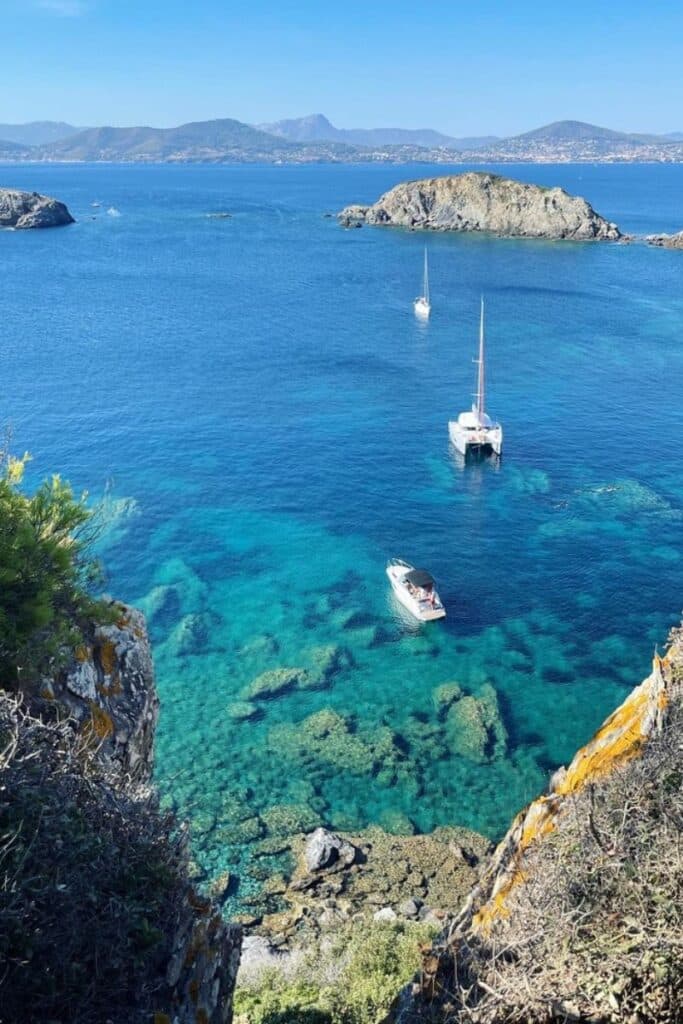
Little Known Fact: So many international and local folks go to the South of France in August that most of the locals head out of town for their own vacation somewhere else.
Despite the crowds, there are so many amazing things to do in the south of France in August – hit the beaches of Côte d’Azur in Nice or Saint Tropez, or a few of the more hidden gems on La Madrague peninsula, explore a few of the famous Provençal villages (my favorite being Gordes and Moustiers-Saint-Marie), attend the local festivals happening in every town, and hike in the Calanques National Park to name a few!
PRO TIP: The end of August is the ideal time to go because the local Europeans are heading back to get ready for school, and the shoulder season travelers that usually come in September are not here yet.
Weather in September – Sunny & Dry (GREAT CHOICE)
This is my favorite time to go to the South of France, and I won’t be shy about saying it. I know everyone is a fan of the summer months, the lavender fields, and the French Riviera beach clubs, but I value the slower (yet still sunny and hot) days of September.
I spent two fantastic trips in the south of France in September, and a few things that I loved most – the water in the Mediterranean is still warm, temperatures are perfect in the 80s°F and sunny, and it’s grape harvest season.
Tourism in September starts to slow down compared to the peak summer months, as children go back to school and fewer families travel. However, it’s still relatively lively, especially in the earlier part of the month.
While the summer’s major festivals have wound down, there are still many local events and festivals in September, celebrating everything from music and film to local traditions and food. In fact, many vineyards in regions like Provence and Languedoc-Roussillon host festivals and events where you can participate in the harvest, enjoy wine tastings, and learn about winemaking – I did this with a local vineyard (woke my ass up at 6 am to get to work, ha!)
PRO TIP: Feria des Vendanges in Nîmes is a wine harvest festival in Nîmes combining bullfighting traditions with celebrations of local culture and, of course, wine.
I absolutely recommend September in the south of France. It is a great month to visit because it allows you to enjoy the region’s beauty, culture, and cuisine at a more relaxed and comfortable pace.
Weather in October – Pleasant
In October, the South of France transitions from the warmth of summer to the cooler, more random conditions of autumn. The weather is generally mild, with average temperatures ranging from around 60°F to 70°F, though it can be warmer in the early part of the month and cooler towards the end.
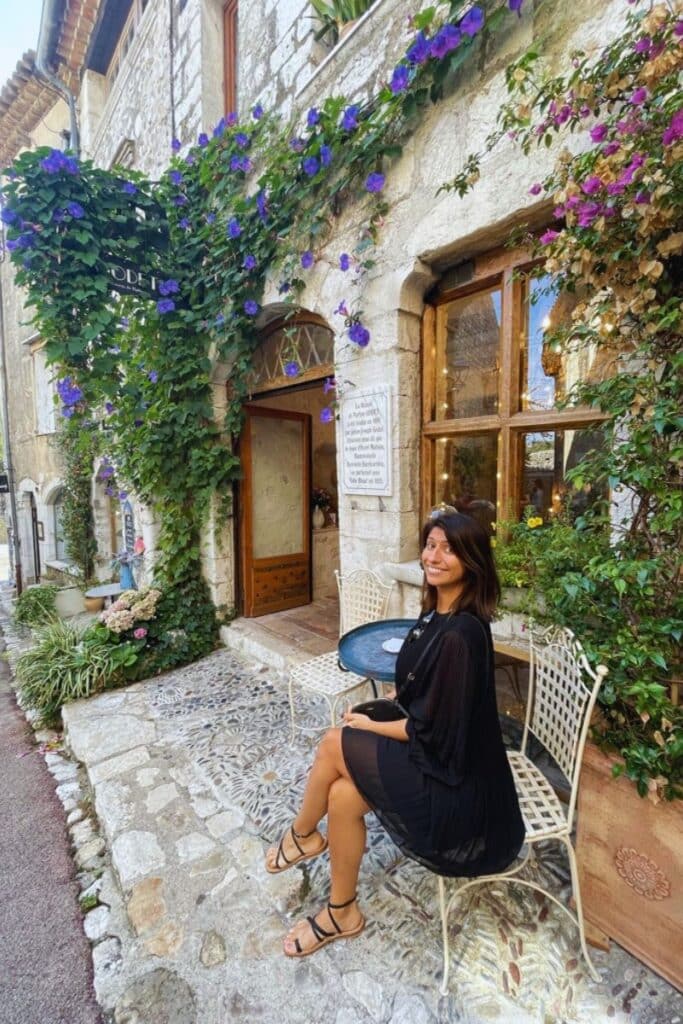
October is a mix of sunny days and higher chances of rain as the month progresses, so I recommend packing a combination of layers and a raincoat.
All that said, traveling to the South of France in October is a pleasant experience. The cooler temperatures are perfect for exploring the countryside, especially in areas like the Luberon or the Alpilles, where the autumn leaves provide a pretty backdrop. And while beaches may no longer be prime for sunbathing, I love the coastal walks along the French Riviera or the Camargue – think dramatic cliffs over a super pretty coastline!
Finally, as a foodie, I think October is ideal for getting chunky in France. The culinary scene shifts to embrace autumn’s harvest, making it a fantastic time to explore local markets and restaurants, which will feature seasonal produce like truffles, mushrooms, chestnuts, and wild game.
Weather in November – Cold & Rainy
This is when temperatures drop to about 50 – 60°F, and the rains come pouring down over France. I’ve been told that most of the villages close down for the winter months, which sort of starts in November, and so things will be very quiet this time of year.
I would personally not travel to the South of France in November.
Weather in December – Cold & Windy
In December, the South of France is low-key and cold, with temperatures typically ranging from around 40°F to 55°F. This month also sees an increase in rainfall, and while snow is rare in the coastal regions, it’s possible in the mountains.
Many towns, especially in Provence, host charming Christmas markets, which are great for picking up unique gifts, tasting holiday treats, and enjoying the Christmas decorations and lights.
Best Time to Visit the South of France by Season
Every season is unique in the south of France, so I’m going to focus on the weather, what you can enjoy as far as festivals, and what to look forward to from a nature perspective. I have a lot more details in the month-to-month breakdown.
🌷 Spring in the South of France
Spring Months: March, April, May
Weather: Cool, Windy, Some Sun (45 -65°F)
While March is definitely cold and rainy, April and especially May brings flowers and a cooler, sunnier vibe to the South of France. The villages start coming alive, cafes fill up again, and restaurants open up from being shut down in the winter.
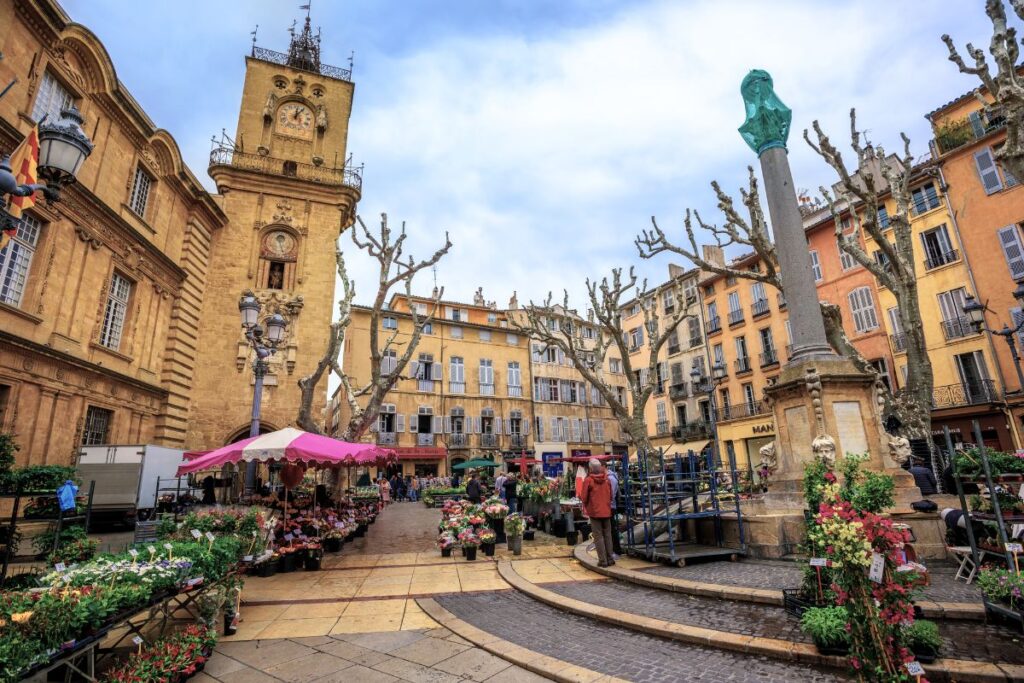
April is also Easter holiday season, so there’s quite a few families with kids and French locals vacationing in the south of France.
Events I recommend in the Spring:
- Fête du Citron (Lemon Festival) in Menton in March
- Feria de Pâques (Easter Feria) in Arles in April
- Nice International Film Festival in April (a bit smaller than Cannes)
- Cannes International Film Festival in May
- Festival des Jardins (Garden Festival) in Côte d’Azur in April.
☀️ Summer in the South of France
Summer Months: June, July, August
Weather: Sunny, Hot, Dry (70-90°F)
July is the best month overall to visit the South of France. It’s poppy season in June, peak lavender season in July and August, and sunflowers in August towards September. July is an especially fantastic time to head to the beach on the French Riviera – my favorite area being La Madrague Peninsula and the beaches around Bormes-les-Mimosas.
Plus, there are quite a few festivals in the summer:
- Festival d’Avignon (Avignon Festival) – a performing arts festival in July.
- Nice Jazz Festival in July.
- Les Rencontres d’Arles in July, which spills over into August and September.
- Festival International de Piano de La Roque d’Anthéron near Aix-en-Provence.
- Fête de la Lavande (Lavender Festival): Held in Valensole area in July.
🍁 Fall in the South of France
Fall Months: September, October
Weather: Sunny, Warm, Dry (60-80°F)
I loved Provence and the French Riviera in September – I was in the water, sunbathing, and the villages were not blistering hot like the summer months. Road-tripping the south of France in the fall months is fantastic as well, because it’s when the locals harvest the grapes, and the leaves (those that are not pine trees) change colors.
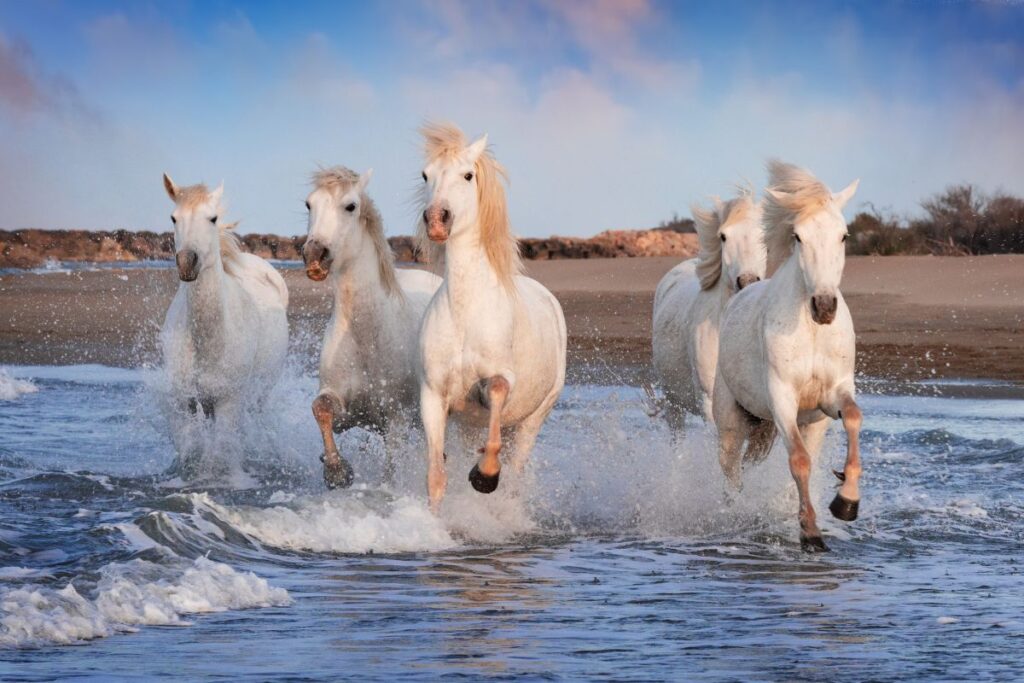
Events I think are fun in the fall:
- Les Rencontres d’Arles in July, which spills over into August and September.
- Feria des Vendanges in Nîmes is a wine harvest festival in October.
❄️ Winter in the South of France
Winter Months: November, December, January, February
Weather: Cold, Windy, Rainy (35 -55°F)
With fewer tourists and the weather being in the 40’s Fahrenheit, windy, and rainy, winter months are a great time to visit museums, galleries, and historical sites in bigger cities like Nice, Marseille, and Aix-en-Provence.
Most of the smaller towns and villages sort of shut down in the winter, with restaurants and cafes closed, so outside of Christmas and New Year, these months are pretty quiet.
Events I think are fun in the winter:
- Christmas Markets in Provence Villages.
- Nice Carnival in February.
FAQ: When To Visit the South of France
If you need quick answers, here’s the frequently asked questions I get when visiting the south of France.
What is the best month to go to the South of France?
I think July is the best month to go to France overall because the weather is hot (90’s F), it’s sunny and wonderful to jump into the Mediterranean, and it’s peak lavender season in the Valensole Plateau area.
This means you get a beach holiday with a sprinkle of iconic Instagram-worthy lavender field photos to make your haters jealous.
When is the best time to visit Provence for lavender?
The best time to visit Provence for the lavender bloom is from late June to early August, with the peak bloom typically happening in July. This is also a popular time for bunches of tourists, so you can expect more crowds, especially in well-known areas like Valensole, Sault, and around the Luberon and Mont Ventoux regions.
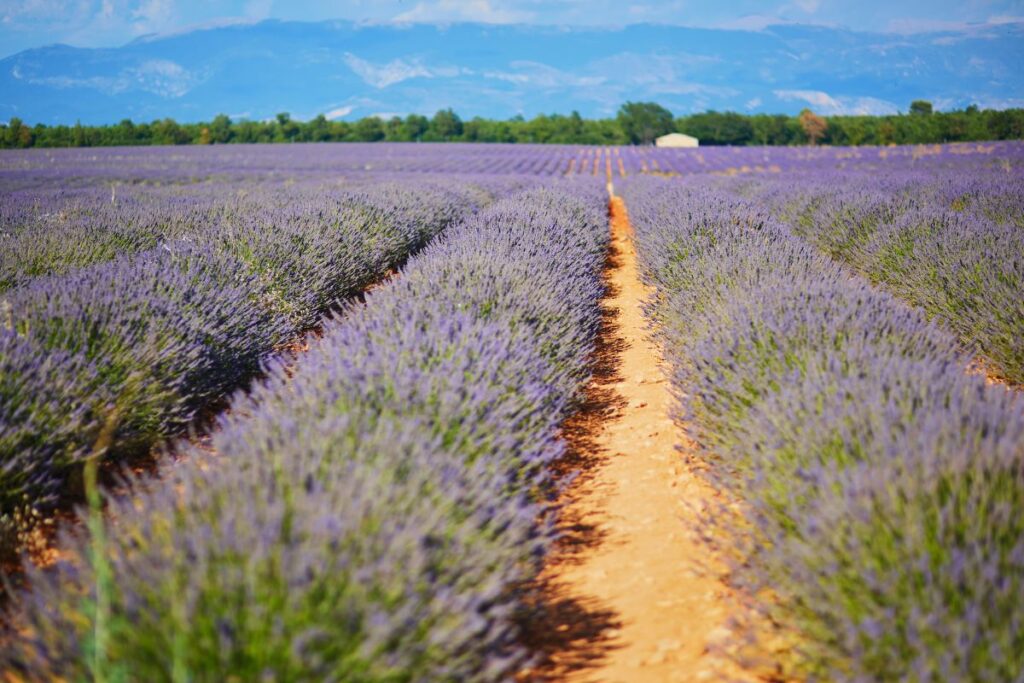
PRO TIP: My favorite place to see and take pictures of the lavender fields is the Valensole Plateau, right next to my favorite town in Provence, Moustiers-Sainte-Marie.
The town of Sault also hosts an annual lavender festival on August 15th, featuring market stalls, traditional Provençal food, and music.
When is the best time to visit France for wine culture?
It’s always wine season in France, so this is a tough question for me to answer. Harvest Season (September to October) is perhaps the most exciting time to visit the south of France for wine-o’s.
The grape harvest, or “vendanges,” occurs, and all hands on deck in the vineyards and wineries. Some vineyards may offer tours that allow you to participate in or observe the harvest and initial winemaking processes. However, because it’s a busy time, it’s a MUST to book visits in advance – simply email or call the winery and check reservations.
When is the worst time to visit the South of France?
The worst time to visit the south of France is in the winter months and when the Mistral wind is in full force. The Mistral is a strong, cold, northwesterly wind that affects the South of France, particularly Provence. It can occur at various times of the year but is most common in winter and spring.
What is the best month to visit Nice, France?
Nice is pretty and hot from May to October, but I thought the best time to visit is in the summer months of June and July. It’s sunny, and just a bit less busy than peak August tourist season.
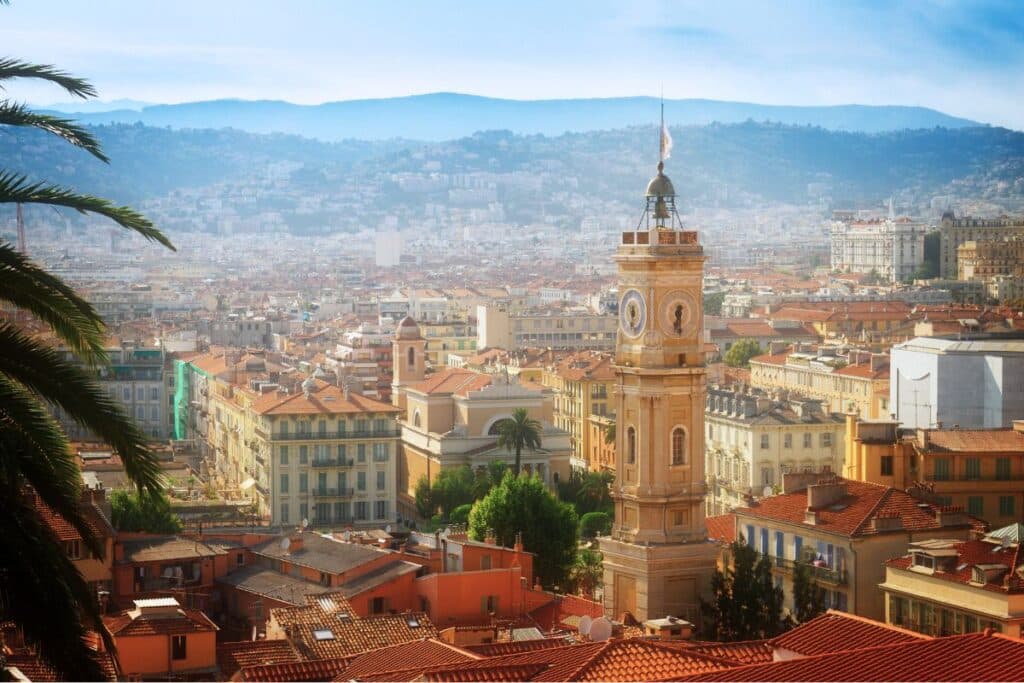
How many days in the South of France is enough?
The south of France is quite a large diverse area, encompassing Provence, the French Riviera (Côte d’Azur), Languedoc-Roussillon, and parts of the Midi-Pyrenees and Aquitaine. I think a solid 10 days is best, but here’s what you can do with more or less time.
- Quick Trip (3-4 days): If you’re limited on time, focus on a specific area. For example, spend a few days exploring the French Riviera, visiting cities like Nice, Cannes, and Eze. Or, choose Provence to enjoy its picturesque villages like Gordes and Roussillon, and perhaps a day in a city like Arles or Aix-en-Provence.
- Bang For Your Buck (5-7 days): With a week, you can explore a broader area. Start with a few days on the French Riviera, then head to Provence to enjoy the countryside, vineyards, and historic towns. This gives you a balanced view of the region’s urban and rural attractions.
- Slow Travel Style (2 weeks or more): With two weeks or more, you can thoroughly explore the South of France. Start in the east with the French Riviera, make your way west through Provence, and continue all the way to Marseille. You’ll have time to visit a bunch of stuff and, more importantly, really feel how deliciously slow life in the south of France can be.
When should I go to the French Riviera?
I think the French Riviera is best experienced in the summer or early fall. There are pros and cons to each season, so here’s my take:
➡️ Summer (June to August): This is the peak tourist season. The weather is warm and sunny, perfect for beach activities, with average temperatures ranging from the mid-20s to low 30s Celsius (77 to 90 Fahrenheit). It’s also the most crowded time, and prices for lodging will be at their highest.
➡️ Fall (September): I might prioritize September for the French Riviera. The weather is pleasant, and the summer crowds have mostly left. It’s a great time to visit for those who prefer a quieter experience, and the sea is still warm enough for swimming.
The Wrap-Up: Best Time to Visit the South of France
The best time to visit the south of France is in the summer months and early fall in my opinion. Having been a few times, here are a few tips to help you decide the type of vibe you want to experience:
👉 May – October: Best for French Riviera beaches – St. Tropez, Cannes, Nice
👉 June: Best for red poppy (coquelicots) season
👉 July: Best for Lavender Fields in Provence (BEST OVERALL)
👉 August: Best for Sunflower Blooms in Provence
👉 September: Best for local festivals & vineyard visits (MY FAVORITE)
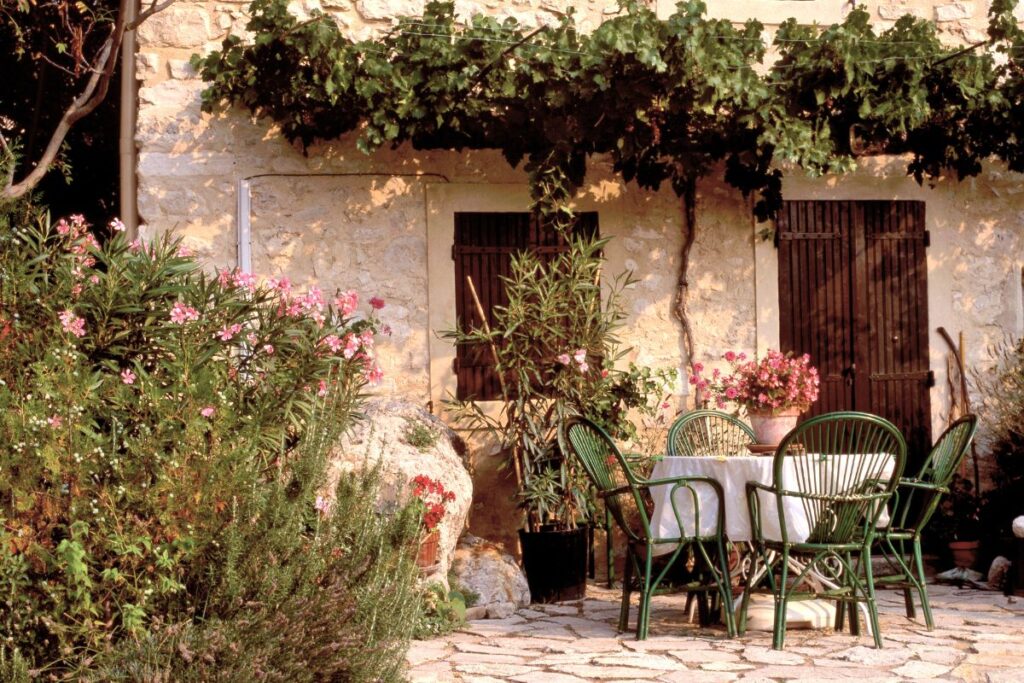
To get you started, here’s a fantastic French Riviera and Provence itinerary you can use as your guide to start planning your trip!
